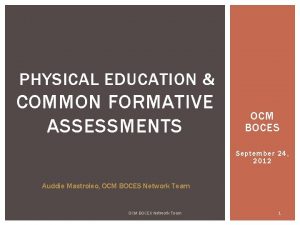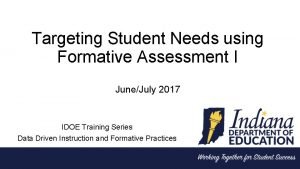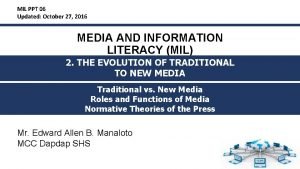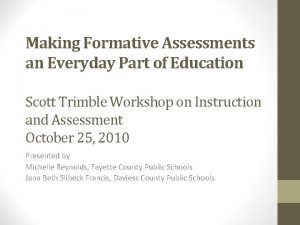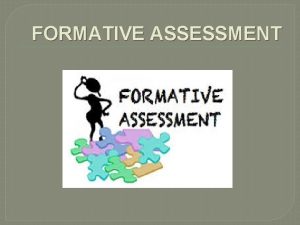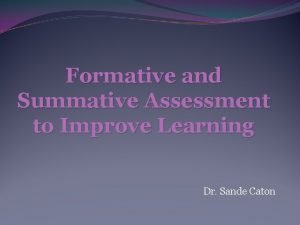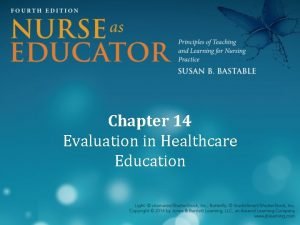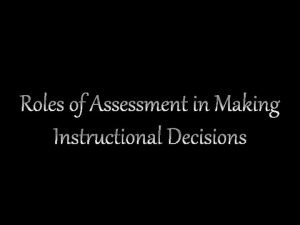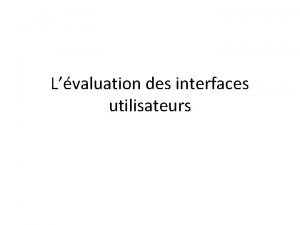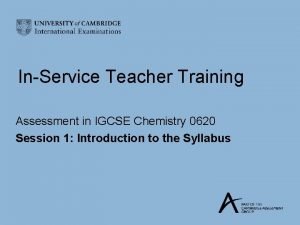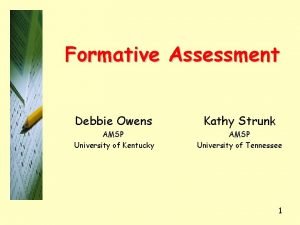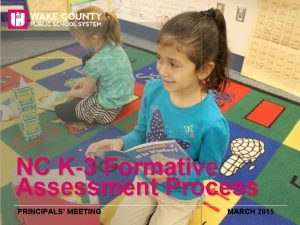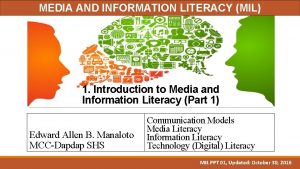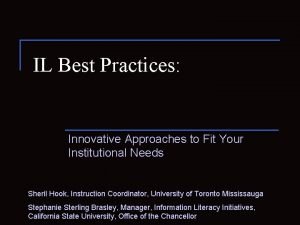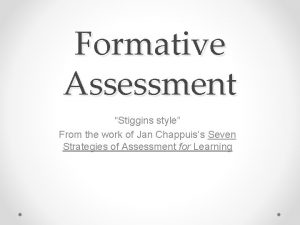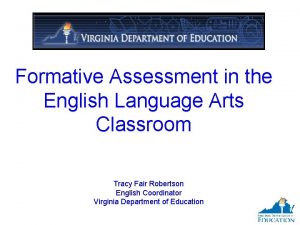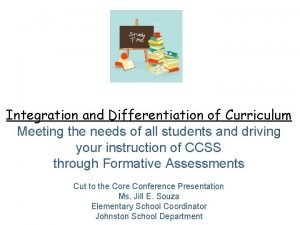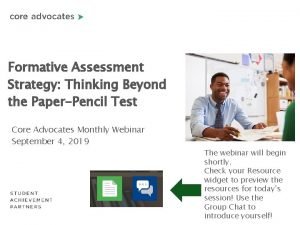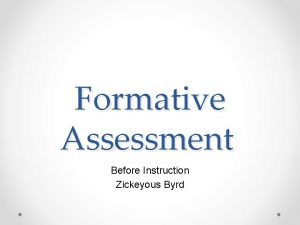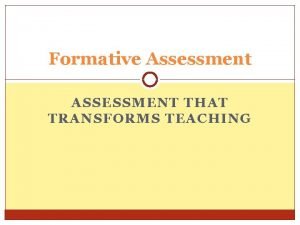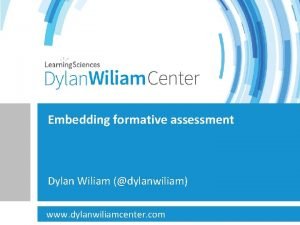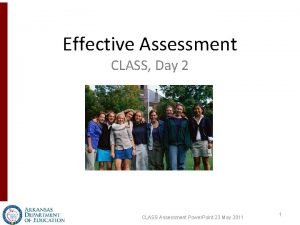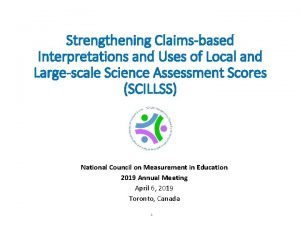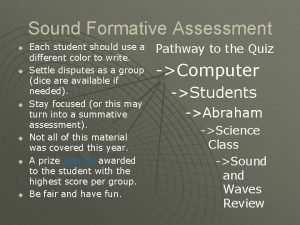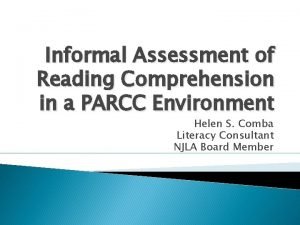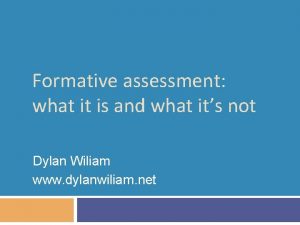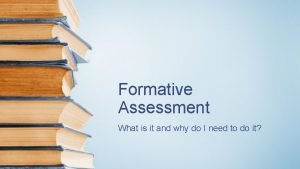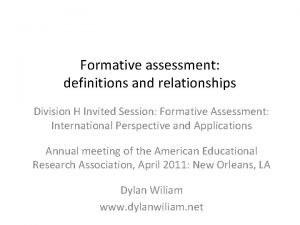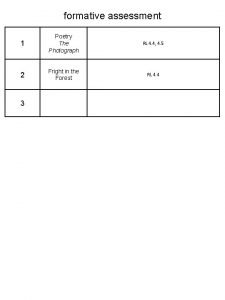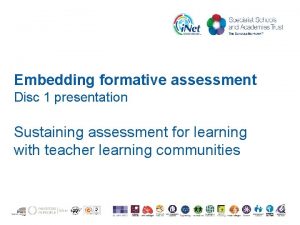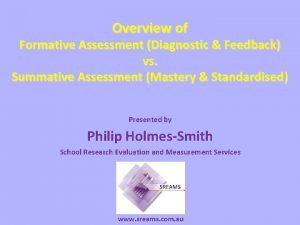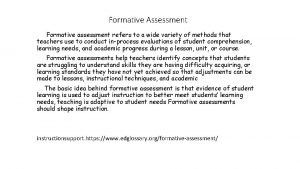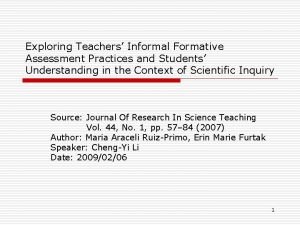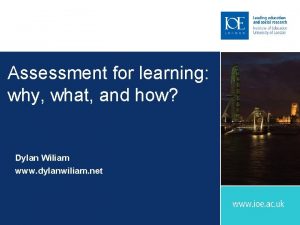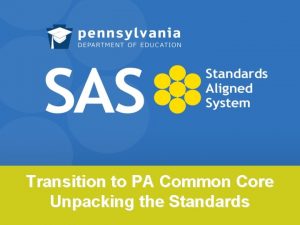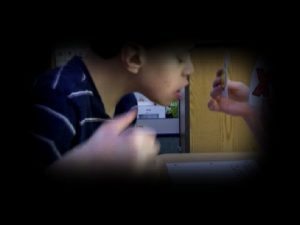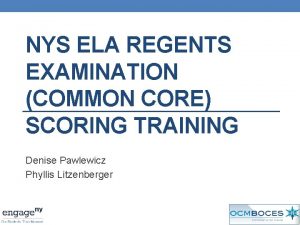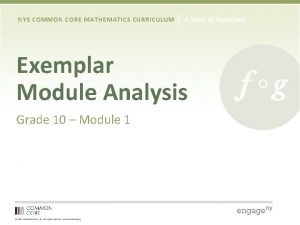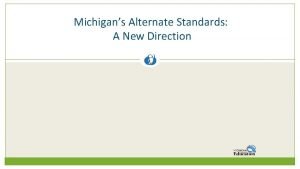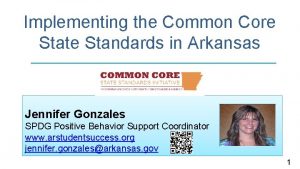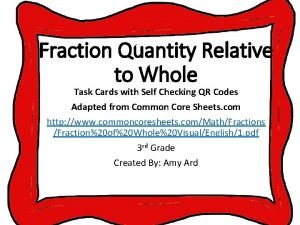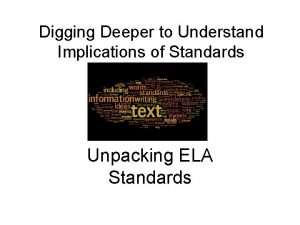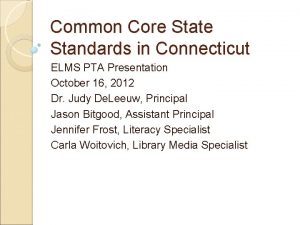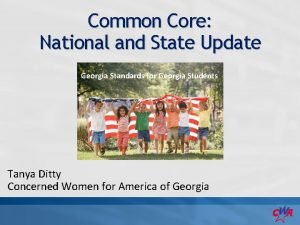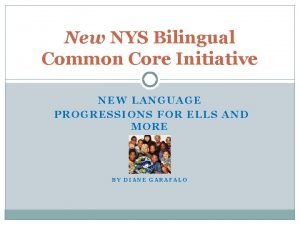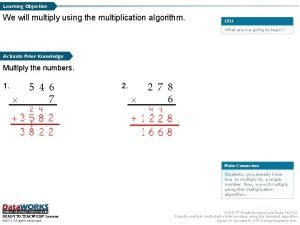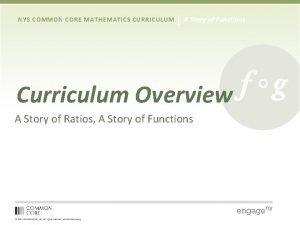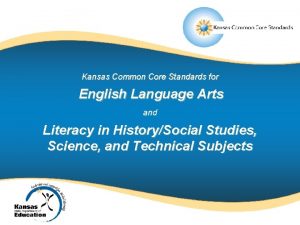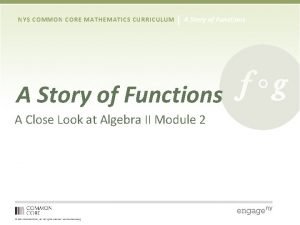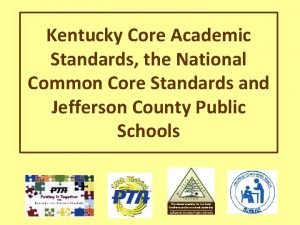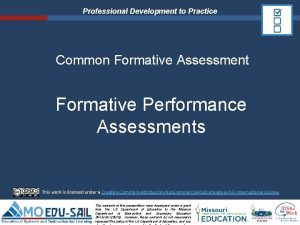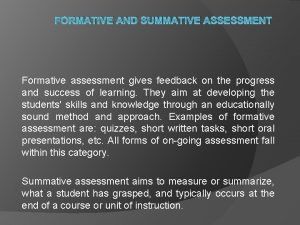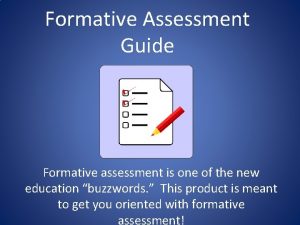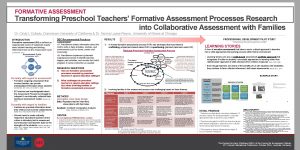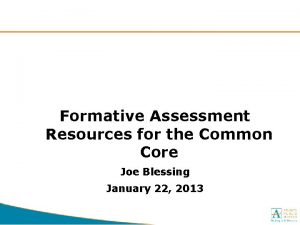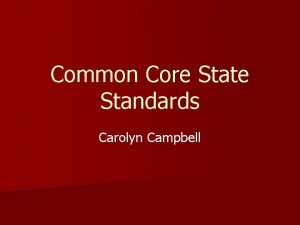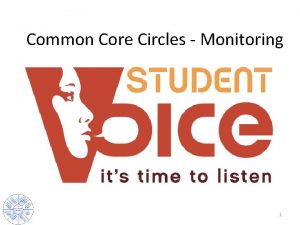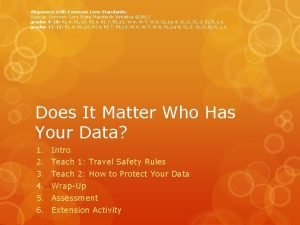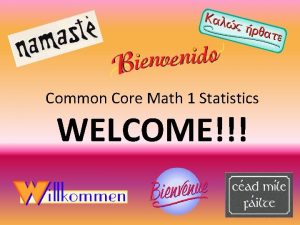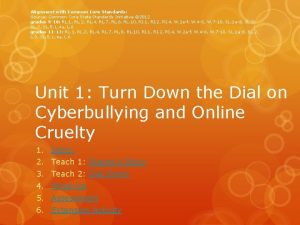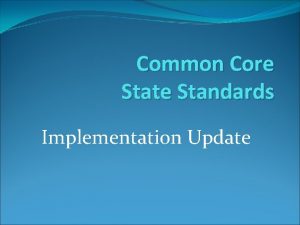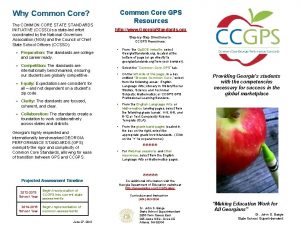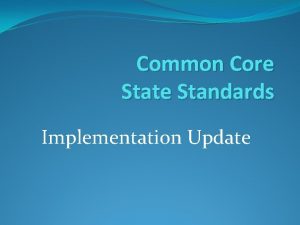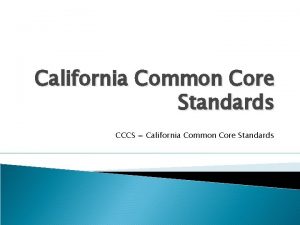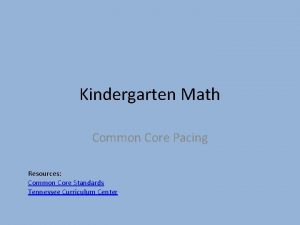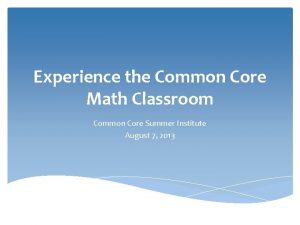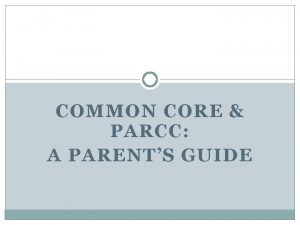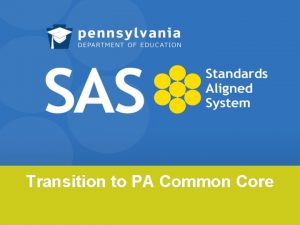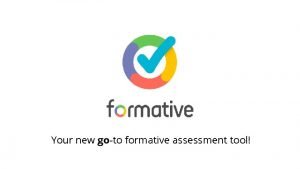Common Core Institute 3 Formative Assessment Formative Assessment






























































- Slides: 62

Common Core Institute #3 Formative Assessment

Formative Assessment Formative assessment is a process used by teachers and students during instruction that provides feedback to adjust ongoing teaching and learning to improve students’ achievements of intended instructional outcomes (FAST SCASS, October 2006)

Formative Assessment • Occurs moment-to-moment as part of instruction • Is a process used by teachers and students frequently and is embedded in the current unit of instruction • Are small scale, short cycle assessments given in the classroom to diagnose where students are in their learning (ASSESSMENT FOR LEARNING--Stiggins, Arter, Chauppuis and Chauppuis, 2006)

Formative Assessment • Cannot aggregate/disaggregate and report results • Use results to provide descriptive feedback or to modify instruction • Most flexible

Formative Assessment: What It Is • A Planned Process • Ongoing • Evidence elicited through classroom assessment • Instructional Adjustments made by teachers • Learning Adjustments made by students

Formative Assessment: What It Is NOT • Unplanned • One Time or Periodic Test • Instructional Adjustments Based on Teachers’ Feelings • A Quick “Fix” or “Magic Bullet”

The Formative Assessment What It Is…Process What It Isn’t… A planned process Unplanned Based on assessment evidence Individual strategies Using evidence to make instructional adjustments and/or verifying learning Moving on regardless of student evidence “Actionable” feedback for students Grading

Formative Assessment Process ETS, 2009

WHY SHOULD WE CONSIDER FORMATIVE ASSESSMENT?

Real Hourly Wages (in 2007 dollars) 1973 -2005 by Level of Education Published by the Economic Policy Institute in 2010 as found in Wiliam, D. Embedded Formative Assessment. Solution Tree. May 2011.

Score Gains on the Wechsler Intelligence Scales for Children, 1947 to 2001

Change in Workplace Skill Demand in the United States (1969 -1999)

Research Base for Formative Assessment Use • Recommended reading: Formative Assessment: Caveat Emptor by Lorie Shepard, ETS Invitational Conference, October 10 -11, 2005 • 1967—Michael Scriven introduces the term “formative assessment” to indicate the evaluation of a program during the planning and developmental stages and making changes in the program for the purpose of improvement. • 1971—Bloom, Hastings, and Maddus introduced the idea that assessment not be used solely to make summative evaluations of student performance but to formatively evaluate learning progress at different phases of teaching, providing students with feedback and correction as a way to remediate. Greenstein, L. What Teachers Really Need to Know About Formative Assessment. ASCD, 2010.

Research Base for Formative Assessment Use • 1977—Benjamin Bloom identified two essential elements of formative learning: feedback for students and corrective conditions for all important components of learning, which led to differentiated instruction. • 1988—Terrance Crooks studied the effect of classroom assessment practices on students and asserted that classroom formative assessment is one of the most powerful forces for improving education and positively affect student motivation. • 1989—Royce Sadler found that assessment is most effective when students can monitor the quality of their own work through specific provisions that are incorporated directly into instruction. Greenstein, L. What Teachers Really Need to Know About Formative Assessment. ASCD, 2010.

Paul Black and Dylan Wiliam (1998) In 1998, Black and Wiliam published the results of a meta-analysis of over 250 research studies on classroom assessment practices entitled “Inside the Black Box. ” They found firm evidence that formative assessment is an essential component of classroom work and that its development can raise standards of achievement, producing effect sizes between. 4 and. 7.

Findings from Black and Wiliam (1998) The research from Black and Wiliam indicates that improving learning through assessment depends on five factors: 1. Providing effective feedback to students. 2. Students’ active involvement in their own learning. 3. Adjusting teaching to take account of the results of assessment. 4. Recognizing the profound influence of assessment on students’ motivation and self-esteem - both crucial influences on learning. 5. Ensuring pupils assess themselves and understand how to improve.

Supporting Research • 2004—Wiliam, Lee, Harrison, and Black, as a follow-up to Inside the Black Box, examined the achievement of secondary students in math and science who were exposed and not exposed to formative assessment and found a mean effect size of. 32 when exposed to formative assessment interventions. • 2004—Ruiz-Primo and Furtak measured the effect of three formative assessment strategies—eliciting, recognizing, and using information—in the science classroom and found that the quality of teachers' formative assessment practices was positively linked to the students' level of learning. Greenstein, L. What Teachers Really Need to Know About Formative Assessment. ASCD, 2010.

Supporting Research • 2006—Robert Marzano concluded that classroom formative assessment is an effective way to plan and apply instructional interventions to close the gap. • 2007—Wiliam and Thompson found that formative assessment produces greater increases in students’ achievement than class-size reduction or increases in teachers’ content knowledge, and at a fraction of the cost. Greenstein, L. What Teachers Really Need to Know About Formative Assessment. ASCD, 2010.

CRITICAL FEATURES OF FORMATIVE ASSESSMENT

Five Critical Features to Guide Educators Toward Effective Use of Formative Assessment • • • Learning Progressions Learning Goals and Success Criteria Descriptive Feedback Self and Peer Assessment Collaboration Heritage, M. Formative Assessment and Next-Generation Assessment Systems: Are We Losing an Opportunity. National Center for Research on Evaluation, Standards, and Student Testing (CRESST).

Learning Progressions • Clearly articulate the trajectory along which students are expected to progress. • Descriptions in words and examples of what it means to move over time toward more expert understanding. • Depict successively more sophisticated ways of thinking about an idea that might reasonably follow one another as students learn. Heritage, M. Formative Assessment and Next-Generation Assessment Systems: Are We Losing an Opportunity. National Center for Research on Evaluation, Standards, and Student Testing (CRESST).

Learning Progressions • Clearly articulate the key subconcepts or subskills that constitute progress toward the subcomponent of the standard. • Developed from a strong research base about the structure of knowledge in a discipline and about how learning occurs (ideally). Heritage, M. Formative assessment: Making It Happen in the Classroom. Corwin, 2010.

Five Characteristics of Learning Trajectories/Progressions 1. Learning trajectories/progressions identify a particular domain and a goal level of understanding. 2. Learning trajectories/progressions recognize that children enter instruction with relevant yet diverse experiences that serve as effective starting points. 3. Learning trajectories/progressions assume a progression of cognitive states that move from simple to complex. While not linear, the progression is not random, and can be sequenced and ordered as “expected tendencies” or “likely probabilities”. Adapted from Confrey, J & Maloney, S. Learning Trajectories. Presentation provided to CCSSO FAST SCASS Collaborative. 2010.

Five Characteristics of Learning Trajectories/Progressions 4. Progress through a learning trajectory/progression assumes a well-ordered set of tasks (curriculum), instructional activities, interactions, tools, and reflection. 5. Learning trajectories/progressions are based on synthesis of existing research, further research to complete the sequences, and a validation method based on empirical study. Adapted from Confrey, J & Maloney, S. Learning Trajectories. Presentation provided to CCSSO FAST SCASS Collaborative. 2010.

Coordinating with Common Core State Standards Learning Trajectories/Progressions can serve as a boundary object to support the coordination of the Common Core State Standards, curriculum, instructional practices, and multiple forms of assessment. Adapted from Confrey, J & Maloney, S. Learning Trajectories. Presentation provided to CCSSO FAST SCASS Collaborative. 2010.

Confrey, J & Maloney, S. Learning Trajectories. Presentation provided to CCSSO FAST SCASS Collaborative. 2010.

Learning Targets and Criteria for Success • Provide the standard against which evidence is elicited, performance is compared (by both teacher and student), and feedback is generated to close the gap between current learning and desired learning goals • Learning targets identify what immediate learning is intended within the Zone of Proximal Development (ZPD). • Success criteria are indications to the teacher and the student of the degree to which learning is moving through the ZPD toward independent achievement. • Should be clearly identified and communicated to students Heritage, M. Formative Assessment and Next-Generation Assessment Systems: Are We Losing an Opportunity. National Center for Research on Evaluation, Standards, and Student Testing (CRESST).

Vygotsky’s Zone of Proximal Development (ZPD) • The ZPD is the distance between what the child can accomplish during independent problem solving and the level of problem solving that can be accomplished under the guidance of an adult or in collaboration with a more expert peer. • Scaffolding characterizes the support that adults give to learners in the ZPD to move them from what they already know to what they can do next. Heritage, M. Formative assessment: Making It Happen in the Classroom. Corwin, 2010.

Descriptive Feedback • Specific and appropriate communication to improve learning while that learning is occurring or evolving • Should focus on the particular qualities of student learning with discussion and suggestions about what the student can do to improve • Can be provided in the form of ideas, strategies, and tasks students can use to close the gap between his or her current level and the next level • Not in the form of a score or grade • Should help the student answer three questions: Where am I going? Where am I now? How can I close the gap? Heritage, M. Formative Assessment and Next-Generation Assessment Systems: Are We Losing an Opportunity. National Center for Research on Evaluation, Standards, and Student Testing (CRESST).

Feedback • Formative assessment is designed to provide feedback at multiple levels: – Feedback to teachers about current levels of student understanding – Feedback to guide students through their own next steps Heritage, M. Formative assessment: What do teachers need to know and do? Phi Delta Kappan. October 2007.

Why Feedback? Formative assessment can enhance learning when it provides students with feedback about specific qualities of their work, and about how to improve. Black & Wiliam, 1998; Crooks, 1988; Kluger & De. Nisi 1996; Natriello, 1987; Rea-Dickens, 2001; Stipek, 1996; Turnstall & Gipps, 1996 Heritage, M. Formative assessment: What do teachers need to know and do? Phi Delta Kappan. October 2007.

Use of Feedback in Closing the Gap • Teachers take steps to close the gap between the students’ current learning and the goal by: – Modifying instruction – Assessing again to give further information about learning – Modify instruction again…and repeat process • Feedback must be used by the student to improve learning in order for it to be effective in closing the gap. Heritage, M. Formative assessment: What do teachers need to know and do? Phi Delta Kappan. October 2007.

Effective Feedback • Clear, descriptive, criterion-based information that indicates: – where students are in a learning progression – how their understanding differs from the desired learning goal – how they can move forward Heritage, M. Formative assessment: What do teachers need to know and do? Phi Delta Kappan. October 2007.

Examples of Feedback That Can Have Negative Consequences • Feedback that is critical (Baron, 1993) – “This work is very poor. You have not tried hard enough. ” • Feedback that is comparative and indicates a student’s standing relative to peers (Black & Wiliam, 1998; Wiliam, 2007) – “Your understanding of this idea is much weaker than the other students in the class. You will need to redo the work to catch up. ” • Feedback that is vague and lacks specificity (Kluger & De. Nisi, 1996) – “Next time, check your calculations. ” Heritage, M. Formative assessment: Making It Happen in the Classroom. Corwin, 2010.

Examples of Feedback That Can Have Negative Consequences • Feedback that is too complex (Kulhavy, White, Topp, Chan & Adams, 1985) – “You are not paying sufficient attention to the features of narrative in your writing. Revise your work, paying attention to the fact that the features of narrative structures can include orientation, complication, and resolution, as well as descriptions of characters and settings. You are emphasizing character and setting without employing a structure that represents the other, important features of narrative. Use all of the features I have indicated above in your next draft. ” Heritage, M. Formative assessment: Making It Happen in the Classroom. Corwin, 2010.

Examples of Feedback That Can Have Negative Consequences • Feedback that draws attention to the student rather than the task (e. g. , praise for task performance) (Kluger & De. Nisi, 1996) – “You are a good student. I am very pleased with you. ” • Feedback provided in relation to a poorly defined goal (Hattie & Timperley, 2007) – “Write two more paragraphs. ” Heritage, M. Formative assessment: Making It Happen in the Classroom. Corwin, 2010.

Guidelines for Providing Feedback That Helps Learners Improve • Feedback should provide more information to the student relating to the task or process of learning that fills a gap between what is understood and what is aimed to be understood (Hattie & Timperley, 2007). • Feedback to students should be about the particular qualities of their work, with advice on what they can do to improve (Bangert-Drowns et. al. , 1991; Black & Wiliam, 1998). • Feedback should be specific and clear and be related to the learning goals (Hoska, 1993; Song & Keller, 2001). • Feedback should provide the learner with suggestions, hints, or cues for how to improve rather than just correct answers (Bangert-Drowns et al. , 1991; Butler, 1987; Kluger & De. Nisi, 1996; Narciss & Huth, 2004). Heritage, M. Formative assessment: Making It Happen in the Classroom. Corwin, 2010.

Guidelines for Providing Feedback That Helps Learners Improve • Feedback should match the student’s cognitive needs—not too complex and not too vague (Bangert-Drowns et al. , 1991). • Feedback should include both verification and elaboration. Verification is the “simple judgment of whether the answer is correct and elaboration is the informational aspect of the message, providing relevant clues to guide the learner toward a correct answer”(Shute, 2008, p. 158). • Feedback should be given after a student has responded to initial instruction. In the case when no learning has occurred, it is better to continue with instruction rather than provide feedback (Hattie & Timperley, 2007). Heritage, M. Formative assessment: Making It Happen in the Classroom. Corwin, 2010.

Timing of Feedback • It is better to avoid providing feedback to students while they are actively engaged in the task (Corno & Snow, 1986). • Immediate feedback (i. e. , immediately after the student’s response) is better for supporting procedural or conceptual knowledge (Dihoff, Brosvic & Epstein, 2003; Corbett & Anderson, 1989, 2001). • When a student is learning a new task, immediate feedback is better (Clarianna, 1990). Heritage, M. Formative assessment: Making It Happen in the Classroom. Corwin, 2010.

Timing of Feedback • In the case of more difficult tasks, involving greater amounts of processing, delayed feedback (i. e. , feedback after several minutes, hours, or weeks) provides more opportunity for students to process (Clariana, Wagner & Rohrer-Murphy, 2000). • Low-achieving students benefit from immediate feedback, particularly when they are learning new concepts or skills they find difficult (Gaynor, 1981; Mason & Bruning, 2001). Heritage, M. Formative assessment: Making It Happen in the Classroom. Corwin, 2010.

Self and Peer Assessment • Important for providing students an opportunity to think metacognitively about their learning • Students evaluate their own learning and their peers learning based upon a success criteria. • The teacher must provide structure and support so students learn to be reflective of their own work and that of their peers, allowing them to provide meaningful and constructive feedback. Heritage, M. Formative Assessment and Next-Generation Assessment Systems: Are We Losing an Opportunity. National Center for Research on Evaluation, Standards, and Student Testing (CRESST).

Metacognition • Teaching students to self-assess so they can internalize and use criteria as they carry out their work increases both the quality of student projects and conceptual understanding (White & Frederickson, 2000) • Engaging students’ prior knowledge to support new learning and the effectiveness of focusing on principled understanding to enable transfer and knowledge generalization (Shepard, 2005) • Transfer is supported when a rich array of tasks is used for both assessment and for instruction (Shepard, 1997) Shepard, L. Formative assessment: Caveat emptor. ETS Invitational Conference. October 10 -11, 2005.

Collaboration • Teachers should work together as partners with students in the learning process through: – Sharing learning goals and success criteria – Supporting students as they monitor and take responsibility for their own learning – Helping students to provide constructive feedback to each other – Involving students in decisions about how to move learning forward – Building a classroom culture of mutual trust Heritage, M. Formative Assessment and Next-Generation Assessment Systems: Are We Losing an Opportunity. National Center for Research on Evaluation, Standards, and Student Testing (CRESST).

Formative Assessment Cycle Where am I now? Where am I going? How can I close the gap? What classroom culture is required? Heritage, M. Formative Assessment and Next-Generation Assessment Systems: Are We Losing an Opportunity. National Center for Research on Evaluation, Standards, and Student Testing (CRESST).

FORMATIVE ASSESSMENT EXAMPLES AND TECHNIQUES

Examples of Formative Assessment • A language teacher asks students to choose the best thesis statement from a selection. If all chose correctly, she moves on. If only some do, she may initiate a class discussion. If most answer incorrectly, then she may review the work on thesis statements (Wiliam, 2006).

Formative Assessment Instructional Strategies • Observations • Effective Questioning • Student Record Keeping

Observations • Go beyond walking around the room to see if students are on task or need clarification • Assist teachers in gathering evidence of student learning to inform instructional planning • Can be recorded and used as feedback for students about their learning or as anecdotal data shared with them during conferencing (evidence of learning) • Sample Techniques: – Anecdotal Notes – Observation Journal Garrison, C. & Ehringhaus, M. Formative and summative assessments in the classroom. AMLE Assessment Resources, 2007.

Effective Questioning • Is used to elicit immediate information about student learning • Allows an opportunity for deeper thinking and provides teachers with significant insight into the degree and depth of understanding [significant wait time] • Engage students in classroom dialogue that both uncovers and expands learning • Examples: – Checking for understanding (thumbs up/down, red/green cards) – Exit slips – Reflection/Analysis/Synthesis Garrison, C. & Ehringhaus, M. Formative and summative assessments in the classroom. AMLE Assessment Resources, 2007.

Student Record Keeping • Helps students better understand their own learning as evidenced by their classroom work • Not only engages students in their learning but also helps them to see where they started and the progress they are making toward achieving the learning goal Garrison, C. & Ehringhaus, M. Formative and summative assessments in the classroom. AMLE Assessment Resources, 2007.

Example Formative Assessment Techniques and Tools • • • • A or nothing ABCD Cards/Corners Admit slips Ask the audience As I see it Best examples discussion Colored cups Concept mapping sticky notes Constructive quizzes Choose-swap-choose Daily sign-in Debriefing Demonstration Exit pass • • • • Extended wait time Find the errors and fix them Generating test items Go 50 -50 Graphic organizers Group-based end-of-topic questions Group-based test prep Hand signals Hinge-point questions Hot-seat questioning Journal entry If you did know what would you say? If you don’t know, I’ll come back to you If you have learned it, help someone who hasn’t

Example Formative Assessment Techniques and Tools • • • • Index card summaries/questions I-you-we checklists Kinesthetic assessments Laundry Day Learning logs Learning portfolios Match the comments to the essays Mini white boards Observation One minute papers One sentence summary One word summary Oral questioning and interviews Phone a friend Plus-minus-equals grading • • • • Popsicle sticks Pose-pause-pounce-bounce Practice Presentations Preflight checklist Question shells Questionnaires Self/peer assessment Ranking exemplars Real-time test Red/green disks Statements rather than questions Think-pair-share Two stars and a wish What did we learn today? Writing frames

Component Criteria Tool Alignment with Learning Goals and Success Criteria There is alignment between the learning goals, success criteria and the assessment tools you have selected. Appropriate to Purpose The evidence generated provides sufficient detail to enable the teacher to make instructional adjustments and provide feedback to move student learning forward. Range of Student Responses Students will be at different points in relation to how they are moving forward to meet the learning goal, therefore, the formative assessment tool should enable the students to show where they are in their learning. Strategic Placement Formative assessment tools are strategically placed in the lesson or series of lessons to provide information to keep learning moving forward toward the learning goal. Multiple Opportunities and Variety of Formats Students are assessed in multiple ways, using a variety of approaches (assessment formats) to show what they know and where they are in their learning. Heritage, M. Formative Assessment. National Center for Research on Evaluation, Standards, and Student Testing (CRESST). Presentation for Iowa Heartland Center. June 2010

FORMATIVE ASSESSMENT IN LESSON PLANNING

Formative Assessment in Lesson Planning K-2 Mathematics Essential Concept from Learning Progression: • Sort, classify, and order objects by size, number, and other properties. Learning Goal: • Understand that objects have characteristics and can be sorted and classified according to those characteristics. Success Criteria: • • • I can identify the rule used to sort a group of objects. I can identify the characteristics that are common in a group of objects. I can sort objects usingle and multiple attributes. I can explain the sorting rule I used to sort the objects. I can re-sort those same objects using a different sorting rule and explain my thinking. Adapted from Iowa ASCD

Formative Assessment in Lesson Planning K-2 Mathematics Formative Assessment Strategies: • Identifying the rule used to sort a group of objects – Observation: Using existing group of objects sorted by characteristics, the student will add another object to an existing group and tell why the object should be included in that group. – Question: Why did you put object X into this group? • Identifying the characteristics that are common in a group of objects – Observation/Dictation: The student will label groups according to the characteristics shared by all objects in the group (i. e. , size, color, shape) • Sort objects usingle and multiple attributes and explanation of sorting rule – Observation/Dictation: The student will resort the group of objects by a single attribute (i. e. , size, color, shape), label each group, and explain the sorting rule chosen. – Observation/Dictation: The student will resort the group of objects by a different set of multiple attributes (i. e. , by size and color, by color and shape, by size and shape), label each group, and explain the sorting rule chosen. Adapted from Iowa ASCD

Formative Assessment in Lesson Planning 3 -5 Science Essential Concept from Learning Progression: • Adaptation of animals to their environment. Learning Goal: • Understand that camouflage plays a crucial part in an animal’s survival in its environment. Success Criteria: • • I can identify three different forms of camouflage. I can generate examples of animals using each of the three different forms of camouflage. I can create a “new” animal that uses camouflage in its environment. I can defend how this newly created animal could survive in its environment through the use of camouflage. Adapted from Iowa ASCD

Formative Assessment in Lesson Planning 3 -5 Science Formative Assessment Strategies: • Identify three different forms of camouflage – Observation/Dictation/Discussion with Peer: The students will determine three different forms of camouflage that animals use to survive in their environment. • Generate examples of animals and their form of camouflage – Observation/Dictation/Discussion with Peer: The students will identify and classify animals based on the three different forms of camouflage. • Create a “new” animal that uses camouflage in its environment – Observation/Chart: The students will create a poster that depicts the characteristics of the “new” animal, including at least one form of camouflage, which will enable it to survive in its environment. • Defend how this newly created animal could survive in its environment through the use of camouflage – Presentation: Using the poster created, the students will present their findings to class and provide evidence of how the use of camouflage could enable the newly created animal to survive in its environment. Adapted from Iowa ASCD

Formative Assessment in Lesson Planning 6 -8 Literacy Essential Concept from Learning Progression: • Developing writer’s purpose Learning Goal: • Understand that one uses analysis to evaluate and interpret format, style, and content to determine the writer’s purpose. Success Criteria: • • • I can identify stylistic devices in a written work. I can identify the main concepts in a written work. I can identify the format employed in a written work. I can identify the purpose of a written work (i. e. , to entertain, to inform, to persuade). I can analyze the use of format, content, and style in a written work to convey the writer’s purpose. Using my own written work, I can defend to peers the use of format, content, and style to convey my purpose for writing. Adapted from Iowa ASCD

Formative Assessment in Lesson Planning 6 -8 Literacy Formative Assessment Strategies: ACTIVITY: What are some formative assessment strategies that you could employ that would measure student progress toward meeting the learning goal? Adapted from Iowa ASCD

Video Modeling Formative Assessment (Olivia Lozano) Please be prepared to follow the video with a time of reflection and response to the video observation questions that are posted on the presentation materials site.

• • • Useful Formative Assessment Websites from Other States Illinois – http: //www. isbe. net/career/html/msp. htm Iowa – http: //educateiowa. gov/index. php? option=com_content&task=view&id= 1072&Itemid=1171 Michigan – http: //www. michigan. gov/mde/0, 4615, 7 -140 -22709_55936 ---, 00. html West Virginia – http: //wvde. state. wv. us/teach 21/Formative. Assessment. html New York – http: //schools. nyc. gov/Academics/Common. Core. Library/Toolkit/Assessme nt/Formative/default. htm
 Common core formative assessments
Common core formative assessments Common formative assessment examples
Common formative assessment examples Formative assessment process
Formative assessment process Mil ppt
Mil ppt Arniel ping/media-and-information-literacy-communication
Arniel ping/media-and-information-literacy-communication Distinguish people as media from people in media
Distinguish people as media from people in media Scott trimble workshop
Scott trimble workshop Formative assessment meaning
Formative assessment meaning Formative assessment
Formative assessment Facets of formative assessment
Facets of formative assessment Rsa evaluation model
Rsa evaluation model Characteristics of formative assessment
Characteristics of formative assessment Formative vs summative assessment
Formative vs summative assessment Igcse teacher training pack
Igcse teacher training pack Round robin charts formative assessment
Round robin charts formative assessment Formative assessment
Formative assessment Formative assessment analyze and explain this illustration
Formative assessment analyze and explain this illustration Formative assessment is tasting the soup while cooking
Formative assessment is tasting the soup while cooking Formative assessment in style
Formative assessment in style Formative assessment
Formative assessment Examples of formative assessment
Examples of formative assessment Examples of formative assessment
Examples of formative assessment Formative vs. summative assessment venn diagram
Formative vs. summative assessment venn diagram Summative and formative assessment
Summative and formative assessment What is the aera
What is the aera Examples of formative assessment
Examples of formative assessment Benefits of formative assessment
Benefits of formative assessment Diagnostic assessment examples
Diagnostic assessment examples Formative assessment
Formative assessment Comparison between formative and summative evaluation
Comparison between formative and summative evaluation Formative assessment
Formative assessment Formative assessment
Formative assessment Formative assessment meaning
Formative assessment meaning Formative assessment for poetry
Formative assessment for poetry Formative assessment
Formative assessment Formative assessment marks
Formative assessment marks Assessment formative summative diagnostic
Assessment formative summative diagnostic Weaknesses of formative assessment
Weaknesses of formative assessment Informal formative assessment
Informal formative assessment Dylan wiliam leadership for teacher learning
Dylan wiliam leadership for teacher learning The brittle, rocky outer layer of earth
The brittle, rocky outer layer of earth Mantle is made up of
Mantle is made up of Crust outer core inner core mantle
Crust outer core inner core mantle Core rigidity
Core rigidity Common core state standards pa
Common core state standards pa Essential elements of state
Essential elements of state English regents part 3 text analysis response
English regents part 3 text analysis response Nys common core mathematics curriculum
Nys common core mathematics curriculum Michigan essential elements
Michigan essential elements Common core standards arkansas
Common core standards arkansas Fraction quantity relative to whole
Fraction quantity relative to whole Unpacking the standards template
Unpacking the standards template Common core state standards ct
Common core state standards ct Georgia common core standards
Georgia common core standards Utah core math standards
Utah core math standards 4th grade math jeopardy common core
4th grade math jeopardy common core Nlap standards
Nlap standards Common core lattice multiplication
Common core lattice multiplication Common core state standards missouri
Common core state standards missouri Whats common
Whats common Kansas english standards
Kansas english standards Lesson 4 from circle-ometry to trigonometry
Lesson 4 from circle-ometry to trigonometry Kcas standards
Kcas standards

